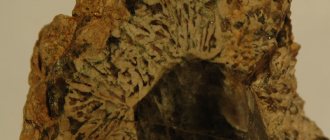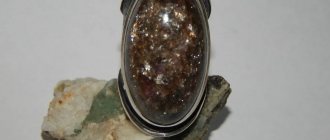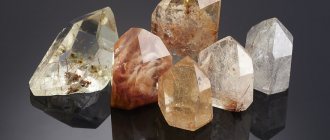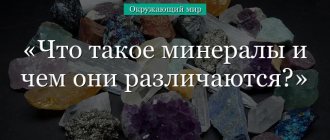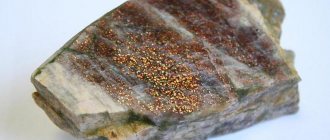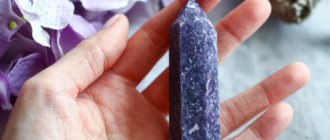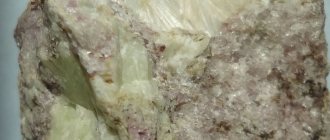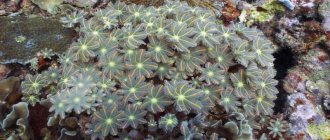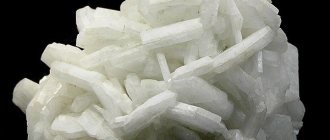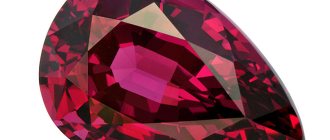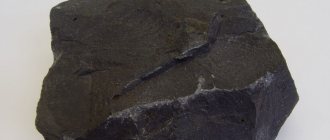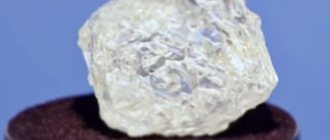Feldspar is such a common group of minerals that it makes up almost half the mass of the earth's crust. The name of this mineral from the class of silicates consists of the Swedish word feldt, which translates as “field”, and the German spath, i.e. "bar" or "plate". It is called field because it is often found on Swedish arable lands, which are located on moraine deposits. The feldspar mineral is characterized by good cleavage: when struck, it easily splits into plates, hence the “bar” in the name. Humanity has long found use for it in various industries, from industry to jewelry.
Composition and properties of feldspar
To better understand what feldspar is, you should look at its composition. From a chemical point of view, it is an aluminosilicate resulting from the combination of A12O3 (aluminum oxide), Na2O (sodium oxide), K2O (potassium oxide) with SiO2 (silicon dioxide). This composition of feldspar explains its structure: it is characterized by a framework type of crystalline structure and the formation of twin crystals. The mineral can be described as brittle, with an uneven, step-like fracture.
The color of the mineral may differ depending on the type of feldspar: the origin and presence of impurities play a significant role here. For example, orthoclase comes in yellow, white, red, and if the color of the stone is blue-black, then you are most likely looking at Labradorite. In addition to the color of the mineral itself, it is also characterized by the color of the trait, which is also the color of the mineral in powder. In the case of feldspar, this color is white.
On the Mohs hardness scale (from 1 to 10), position number 6 belongs to feldspar, the properties of which are characterized as follows: the stone can scratch glass, it is processed with a file. Rutile and opal have similar hardness. Density varies from 2.54 to 2.75 g/cm³. For reference: oil has the lowest density, namely 0.8 g/cm³, and the highest density belongs to iridium and is 22.8 g/cm³.
Microcline
Microcline is a potassium triclinic feldspar with the same formula as orthoclase. In this case, sodium is able to partially replace potassium (although to a lesser extent than in orthoclase). Triclinic high-temperature alkali feldspar, which contains more sodium than potassium, is called anorthoclase. It is characteristic of some effusive, sodium-rich, less often alkaline, intrusive rocks.
Anorthoclase is very similar in physical properties, including the nature of twinning, to microcline. In addition to the Carlsbad and other simple twins that are characteristic of orthoclase, it can be polysynthetically twinned according to the albite law, while the lateral pinacoid is considered both an intergrowth plane and a twinning plane.
The intersection of these two series of strips at almost right angles produces a “lattice” effect when the microcline is observed in polarized light under a microscope. But only maximal microclines, which are characterized by a small degree of structural order, are considered lattice. The main color of the microcline is white, less often pink or red, gray, and occasionally green.
Types of Feldspar
Depending on the chemical composition, feldspars can be divided into 3 subgroups:
- sodium-calcium (plagioclase);
- potassium;
- potassium-barium, or hyalophanes.
Soda-calcium feldspars make up a significant portion of metamorphic and igneous rocks. The general formula is (Ca, Na)(Al, Si) AlSi2O8. They are characterized by the twinning effect and triclinic crystal structure. Plagioclases include oligoclase, labradorite, albite, bytownite, andesine, and anorthite.
Potassium feldspar has the formula KAlSi3O8. This type of mineral is of igneous origin and is much stronger than representatives of the plagioclase group. The group includes sanidine, microcline, orthoclase and adularia. All of them have one chemical formula, but the ordering of the crystal lattices differs. They can be distinguished from plagioclases by coloring: as a result, plagioclases will change color to red-brown (except for albite).
Potassium-barium feldspars are very rare and are represented by celsian. Formula - BaAl2Si2O8. The value of these cream-colored stones is exclusively collectible. Note that the physical properties of minerals of different subgroups are very similar, despite differences in chemical composition.
Price
Industrial spar raw materials are sold on the world market at $85–105 per ton. They charge even more for sanidine, an essential component of elite “bone” china.
Russian stores offer to buy jewelry and collectibles from all over the world (price/rub.):
- heliolite (bead, diameter 2 mm) – 92;
- amazonite (30x45x43 mm, India) – 1,800;
- sanidine (36x13x18 mm; Madagascar) – 820;
- microcline (43x25x41 mm, Kola Peninsula) – 200.
The most expensive of jewelry spars is heliolite. Prices for jewelry with such inserts are thousands (silver) or tens of thousands (gold) rubles.
Deposits and production
Feldspar makes up a significant portion of the earth's crust, so it can be found in many parts of the world. There are many deposits in the Russian Federation, here are some of them:
- Northern Caucasus (Karachay-Cherkessia);
- North-Eastern region (Chukotka Autonomous Okrug);
- Southern Siberia (Tuva);
- Transbaikalia;
- Kola region (Murmansk region);
- Southern Urals (Chelyabinsk region);
- Middle Urals (Sverdlovsk region).
Large deposits are known in Sweden, Norway, USA, Ukraine, India, Tajikistan, Japan, and Madagascar. Feldspar deposits come in several types depending on the origin of the mineral. The following are distinguished:
- pegmatite;
- igneous;
- sedimentary;
- weathering;
- hydrothermal;
- metamorphogenic;
- effusive-sedimentary.
Feldspar is mined very actively, because it has applications in a wide variety of industries. It is used to make glass, in ceramics, as a light abrasive, and as a raw material for rubidium. Its role in jewelry is also important: many types of stones are particularly beautiful and are even valued at a tidy sum. In addition, the mineral is credited with magical and healing properties.
How to distinguish from a fake
Most feldspars are not very expensive, but counterfeits still exist. To determine them you need:
- hold the sample in your hand - the fake glass will heat up very quickly, but the pebble will remain cool for a long time.
- Pay attention to the weight - the stone is heavier than the imitation.
- Any spar will easily scratch glass.
- Rate the type of stone:
- on the surface of the amazonite there should be a pattern in the form of a grid of squares;
- adularia, if you look through it into the light, shimmers inside;
- in a Labrador, if you twist it, iridescence appears, similar to a rainbow. The fake has a poorer range of colors, and the shine is not uniform when turned.
Magic properties
Since ancient times, people have tended to attach magical meaning to various objects. Varieties of feldspar are no exception: the beautiful coloring of the stones is of interest to many sorcerers, witches and healers, who find use for the mineral in a variety of practices.
Particularly popular is moonstone, well known for its pale blue color and radiant shimmer. Its other name is adularia. This type of mineral is rare, so albite, sanidine, microcline, labradorite, oligoclase, or even counterfeits made of frosted glass with an iridescence effect are often sold under the guise of moonstone.
Silver earrings with cubic zirconia and moonstones (go to the SUNLIGHT catalogue)
As its name suggests, the stone is believed to have a connection with the Moon, so its power is believed to depend on the lunar phases and reaches its peak at the new moon. Moonstone can attract good luck and protect its owner from evil spells, and will help unmarried girls find their soul mate. In addition, it pacifies anger and promotes relaxation and calm. Moonstone is especially recommended for those born under water signs: Pisces, Cancer, Scorpio. Positively affects such chakras as Sahasrara, Ajna, Anahata, Manipura.
Labradorite, often mistaken for a moonstone, is also suitable for use as a talisman. It promotes the development of intuition and hidden abilities, and helps protect the home from harm. If moonstone is good for young people, then labradorite is more suitable for mature, experienced people. Influences the Manipura chakra.
Silver earrings SL with quartz and labradorite (go to the SUNLIGHT catalog)
Amazonite helps you become more confident and decisive. This turquoise-colored stone reduces anxiety and brings peace, and gives family people harmony in relationships. By its nature, it carries softness and tenderness, so the fair sex should pay attention to it. Amazonite is suitable for Pisces, Capricorns, Virgos and Libra. Positively affects the Anahata and Vishuddha chakras.
Sunstone (special effect orthoclase) has the ability to bring balance to opposites. In addition, it is responsible for vital energy, strength and joy, helps the development of intuition and wisdom. This type of mineral is good for those who lack positive energy and confidence for new endeavors. Suitable for those born under the signs of Leo and Aries. Affects the Manipura, Anahata and Svadhisthana chakras.
Origin, history
Feldspars are a group of minerals belonging to the silicate class. The reasons for their formation: volcanic activity, displacement of tectonic plates, exposure to sediment and wind. These minerals make up 60% of the volume of the Earth's igneous rocks .
Feldspars are not uncommon in space: the Moon is rich in them, as well as most meteorites.
Feldspar is the most common rock (along with quartz) and rock-forming material.
In mineralogy, the term “feldspar” refers to a group of four dozen minerals.
What does feldspar look like? It is colorless, inconspicuous, and rarely found in its pure form.
The bulk of these minerals have various impurities, so they differ from each other in chemical composition and type.
The scientific term for these stones in the form of Feldtspat was introduced in the 18th century , derived from the Swedish word feldt (field) and the German spath (bar). The fact is that “bars” of this mineral are often found on arable land in Sweden.
People began to use spar a very long time ago, this is confirmed by archaeological finds. During excavations at the site of ancient Mesopotamia, as well as in Egypt, products made from these minerals (household utensils, jewelry) are found.
In ancient times, the Chinese, having invented a method for making porcelain, added spar powder to the clay so that the dishes, vases, and decorative figurines were durable.
Scientists are studying the properties and capabilities of this stone. In our time, such studies are also being carried out, and a comprehensive description of feldspar has been made.
Medicinal properties
Lithotherapy (treatment with stones) actively uses varieties of feldspar. The mineral is believed to have a positive effect on the nervous system and help fight stress. Below is a brief description of the capabilities of the varieties of this stone used:
- Amazonite. Massage with amazonite balls is practiced, as a result of which the condition of blood vessels and skin improves, and metabolism is restored.
- Bull's Eye (Labrador Retriever variety). Helps lower blood pressure and has a positive effect on the genitourinary system.
- Sanidin. Used for swelling and insomnia. Helps relax.
- Albite. Used for diseases of the liver, stomach, kidneys, spleen. It is advised to apply the stone to the area of the affected organ and leave it there for a while.
- Adular. Used for sleep disorders and overexcitation of the nervous system.
Silver ring SL with alpanite, cubic zirconia and moonstones (go to the SUNLIGHT catalog)
- Labrador. Helps treat impotence and infertility, diseases of the genitourinary system.
- Sun stone (heliolite). Treats nervous disorders, fills with vital energy. Helper in the fight against allergies.
This is just a brief description of the possibilities of using feldspar. The bowels of the Earth are infinitely rich and are capable of providing a person with the necessary resources for both industrial needs and for caring for the body and soul, not to mention the material for creative self-expression. Whatever stones you choose, they will share positive energy with you and add a special charm to the owners of jewelry and accessories made from them.
Compatibility with other stones
Each stone in the feldspar group has friendly minerals, as well as undesirable neighbors. In addition, there are combinations in which one or another gem maintains neutrality in relation to another.
The best partners for the adular are:
- onyx;
- lapis lazuli;
- pearl;
- amethyst;
- sapphire;
- coral.
Moonstone will be hostile to malachite, jasper, garnet and agate.
Labradorite is ideally combined with the following minerals:
- beryl;
- rose quartz;
- aquamarine;
- opal;
- topaz;
- amber;
- nephritis;
- amethyst.
You should not combine Labradorite with ruby, jasper, diamond, garnet or carnelian due to planetary incompatibility.
Amazonite is suitable for:
- rauchtopaz;
- jasper;
- fire opal;
- aquamarine;
- rhinestone.
The hostility of the planets does not allow Amazonite to be worn together with morion, agate, onyx or black and white sardonyx.
Labradorite, adularia and amazonite combine well with each other, complementing each other.
